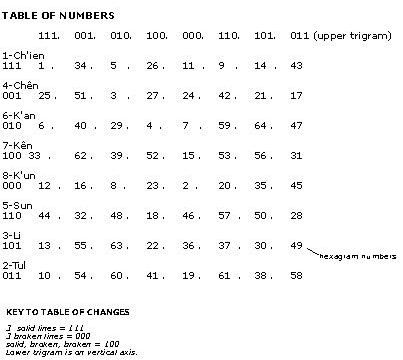
The I Ching (pronounced yee jing)
 Also
known as the Book of Changes, the
I Ching is the first and most important book
Also
known as the Book of Changes, the
I Ching is the first and most important book
of the ancient Chinese
texts called the Five Classics. It has had a significant philosophical
influence outside of China, particularly in Japan and Korea, but
also on Western art
since the end of the Second World War.
Originating early in the Chou dynasty
(about 1122-256 B.C.), the I Ching, in its most
primitive, was
used to divine or predict the future.
Containing figures made up of
broken and
unbroken lines, these were later combined to form symbolic
figures called
trigrams. Over time, evolved, each representing
certain qualities and concepts.
Eventually, the trigrams were
combined to form 64 six-line figures called hexagrams.
Interpretations, called judgments, explained the general significance
of every hexagram in an associated
text.
Each line, beginning from the bottom, was given a meaning to guide
one's actions.
Someone who wishes to consult
the I Ching follows a specific process which involves dividing
special sticks
or coins to select a hexagram. These are used to
form a hexagram which is then interpreted by referring
to a related
subtext.
By the 500's B.C., the I Ching had also
developed into a book of philosophy with Confucius teaching it
as
a book of moral wisdom. The Ten Wings were written by his followers
to comment on the I Ching.

Click hexagram numbers to see associated lycon. .
I Ching | global parameters| soundparameter links | strike positions | density | dynamics | turning | tintchart | muting | divining